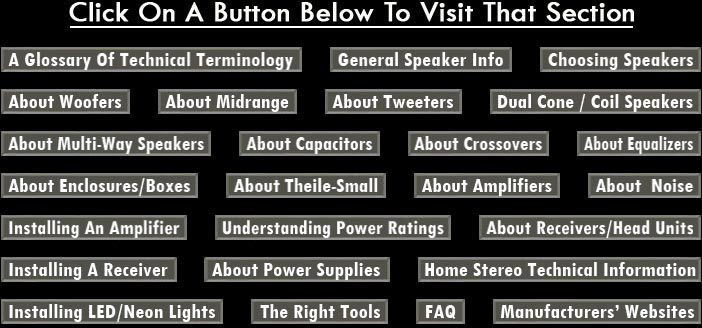


DAC (D/A)
Digital to analog converter. An IC component or circuit that is used to derive or convert an analog signal from a digital one.
Damper
Part of the suspension connected to the bottom of the speaker cone at the voice coil that centers the voice coil in the magnetic gap. It is sometimes referred to as the spider
Damping
As Newton observed, an object once set in ,motion will keep on moving unless a restrictive counterforce is applied. Damping is that force at work in the mechanical resistance that is applied to a speaker cone to keep it from resonating in the absence of an input signal. It is also the factor that is applied as a control voltage by the amplifier for the same purpose. These measures help reduce or dampen Harmonic Distortion. This also improves bass accuracy.
Damping Factor
The ratio of rated load impedance to the internal impedance of an amplifier. The higher the value, the more efficiently an amplifier can control unwanted movement of the speaker coil. A high damping factor is crucial for large speakers that reproduce bass. Usually the higher the number, the better, although it is debatable if anything over 50 is audible. Damping factor is calculated by dividing the load (speaker) impedance by the output impedance of the amplifier. Thus, a given amplifieras damping factor will decrease as the speakeras impedance decreases. This means an amp optimized at 4 ohms will provide tighter bass than at 2 ohms.
DC/DC Converter
Since 12 volts limits the amplitude of an audio signal, a group of components within an amplifier converts battery voltage (DC) into AC so that it can be increased by swetching devices and a transformer, and converted back to DC (rectified). This provides higher voltage to drive the amplification stage to higher power. Also called the Power Supply circuit.
DC
Direct Current.
Decay
The time of reduction of the level of a signal immediately after its cessation.
Decibel or dB (see also Efficiency and Sensitivity)
One tenth of a Bel. This is a measurement of the comparative strength of two powers, and can be applied when measuring any signal in the audio, video, and electromagnetic spectrum. If two powers differ by one Bel, there is a difference of 10 times the power. If comparing amplifiers, where one is rated at 10 watts while the other is 100 watts, then we have a difference of 10 decibels, or one Bel. Decibels should be understood as ratios, not fixed quantities.
Decibels are the preferred method and term for representing the ratio of different audio levels. It is a mathematical shorthand that uses logarithms (a shortcut using the powers of 10 to represent the actual number) to reduce the size of the number. For example, instead of saying the dynamic range is 32,000 to 1, we say it is 90 dB [the answer in dB equals 20 log x/y, where x and y are the different signal levels]. Being a ratio, decibels have no units. Audiologists generally assert that 1 decibel is the smallest difference in volume that can be heard by the average person. The term is derived as an honor to Alexander Graham Bell, who invented the telephone, and did much of the preliminary work in the modern science of acoustics.
Delay
A signal processing device or circuit used to delay one or more of the output signals by a controllable amount. This feature is used to correct for loudspeaker drivers that are mounted such that their points of apparent sound origin (not necessarily their voice coils) are not physically aligned. Good delay circuits are frequency independent, meaning the specified delay is equal for all audio frequencies (constant group delay). Delay circuits based on digital sampling techniques are inherently frequency independent and thus preferred.
Destructive Interference ( phase cancellation)
A phenomenon that occurs when speakers are 180 degrees out of phase, i.e., what one speaker is trying to produce, the other speaker is fighting to cancel. One speaker's wave is in the positive phase (rarefaction), while the other speaker's wave is in the negative phase (compression).
Detachable Face
Occasionally referred to as 'Removable Panel' or 'Theft Deterrent Faceplate', or some variation. This is a physical method for foiling receiver thieves. The idea is that you take just the front panel with the controls with you when you leave the car. A thief cannot buy a new face for a unit unless he has a receipt for it. Some manufacturers makes sets with rotating faces called Mask.
Diaphragm
This term describes the sound-producing element in a tweeter, or Horn. This is the surface that produces the sound you actually hear. The motor that drives it can be any of several technologies including Piezo, conventional dynamic, or ribbon types. Diaphragms do not produce low and low midrange frequencies well, so they are not usually found in that application.
Die Cast (basket)
A type of speaker basket or frame that is cast as a single piece of relatively thick, rigid metal. This contrasts with a Stamped frame that is shaped by pressure, much like a car body fender. Cast metal is heavier and more rigid, and thus less likely to "ring" at certain frequencies, and will hold its shape somewhat longer against the pull of gravity. This is mainly advantageous in the larger woofers of 12" or greater. Smaller drivers will likely not benefit perceptibly from being cast.
Diffraction
a change in the direction and velocity of a wave front that is caused by the wave moving past an obstacle.
Diffuse
Widely spread out or scattered; not concentrated.
Diffuser
A commercial device like a lens or grillwork that diffuses, or scatters sound
Digital Amplifiers
See article on "amplifier classes"
Digital Technology
Human beings directly process information in an analog format. That is, our senses directly convey information to the brain in the form of constantly varying amplitudes and frequencies that approximate the impact of outside stimuli upon the receptors (eyes and ears, etc.) of the organs involved. Digital technology is a method of translating this same information in the form of packets (bytes and bits) of numerically equivalent values. This enables input transducers (microphones, cameras, chemical sensors, etc.) to produce differential waveforms that can be reduced, down to the smallest differences, to a number. This number is transmitted to a receiver with a digital to analog converter that allows the original analog information to be reconstructed for the benefit of our human brains. This is of course an egregiously simplified explanation of the most significant technology of the present time. We invite you to explore more this topic deeply, not just for audio/video, but to understand the new world we have entered.
DIN
Acronym for Deutsche Industrie Norm (Deutsches Institut fuer Normung), the German standardization body. A world reference standard for the mounting parameters of many common receivers ( Head ends) as well as other types of cables and equipment. Single DIN is the standard face size for receivers, and measures 7-3/8"wide by 2-1/4" high. DIN+1/2 measures 7-3/8"wide by 3-3/8"high. Double DIN measures 7-3/8"wide by 4-1/2" high.
Direct sound
Sound that arrives at the listeners ear first.. Sound reaching the listening location without reflections, i.e., sound that travels in the most direct path from the source to the listener.
Discrete Output Devices
A separate active unit in an amplifier, capable of performing a single essential function within the output circuit. There are three basic types of output devices found on car audio amplifiers a integrated circuits, bipolar transistors, or MOSFETs. Integrated Circuits (or IC)are found only on relatively low-wattage (20 watts RMS per channel or less) amplifiers and receivers. An IC incorporates many functional devices and thus is not considered a discrete output device. Most cannot handle more than 25 watts RMS.
Bipolar transistors and MOSFETs are found on the output stages of high powered amplifiers. They are fast enough and can handle enough current to provide power in excess of 20 watts per channel to speakers. Both of these types of transistors are considered discrete output devices. Usually there are two per channel, but some amps feature as many as eight per channel.
Dispersion
The extent to which a sound emitter yields acoustic radiation over a given area. This is a particular concern in tweeters and midranges whose portion of the audio spectrum has a much more directional character than woofers. Many Horn tweeters, while very energetic, have a more limited area of dispersion within which their effect can be fully perceived. Generally, Dome tweeters can be heard over a much wider area, all other factors being equal. But each particular example must be assessed individually for this factor. Some radiator designs are better than others.
Displacement
The measurement of cubic volume that an item (such as a speaker or port) takes away from the internal volume of an enclosure. When designing an enclosure, this figure must be added to the enclosure volume .
Distortion
Any departure from a true and accurate reproduction of the original waveform. It can include Noise, Clipping Distortion, Harmonic, and Intermodulation Distortion. These last two forms are fairly common in loudspeaker reproduction and can be reduced but not entirely eliminated in the existing technology. It would be fair to say that modern amplifier design fairly eliminates nearly all forms of inherent perceived distortion, leaving only that caused by inappropriate user settings and overloading.
Distortion is the name given to anything that alters a pure input signal in any way other than changing its size. The most common forms of distortion are unwanted components or artifacts added to the original signal, including random and hum-related noise. Distortion measures a system's linearity - or nonlinearity. Anything unwanted added to the input signal changes its shape (skews, flattens, spikes, alters symmetry or asymmetry). A spectral analysis of the output shows these unwanted components. If a circuit is perfect, it does not add distortion of any kind. The spectrum of the output shows only the original signal - nothing else - no added components, no added noise - nothing but the original signal.
It's rather amusing to see amplifier manufacturers making great claims about the advantage of the extra .001 % Distortion they've wrung out of their products, while most speakers are considered very good if they can keep such distortions below 5 %. It's true that the reduction of any distortion anywhere is a positive contribution to the goal of high fidelity, but the disparity between the two technologies in this regard points up the largely subjective nature of many such claimed advantages.
Diversity Tuner
An FM tuning method which employs two antennas. The tuner can switch between the two antennas in order to attain better reception.
Dolby
The most common shared logo or feature between all brands is the Dolby labs' 'double D' symbol. Named after audio engineer, Ray Dolby, it represents a number of sound processing technologies that are incorp-orated in a diverse number of products since the early 1970's.
Dolby DigitalA(r)
Dolby's name for its format for the digital soundtrack system for motion picture playback. Utilizes their AC-3 method of digital compression. The signal is optically printed between the sprocket holes. Introduced to Home Theater on laser disc and DVD and CD. Dolby Digital may use any number of primary audio delivery and reproduction channels, from 1 to 5, and may include a separate bass-only effects channel. The designation "5.1" describes the complete channel format. Surround decoder systems with Dolby Digital automatically contain Dolby Pro Logic processing to ensure full compatibility with the many existing program soundtracks made with Dolby Surround encoding.
Dolby Noise Reduction
Decodes Dolby-encoded cassette tapes during playback to virtually eliminate the tape hiss which is especially apparent in quiet environments. Dolby B is the most widely used system. Dolby C is an extension that is even more effective at increasing the signal-to-noise ratio.
Dome Tweeter
Tweeters come in several different types; cones, horns and domes being the most popular. Dome types are heavily favored in many standard applications. They are efficient, and have low Distortion and wide dispersion. There is a choice between hard and soft dome materials, but all have relatively low mass and high power handling capabilities. This same design in a larger form is quite effective as a midrange Driver also, and for many of the same reasons.
Double Stacked (magnet)
Two magnets overlaying each other to increase the overall magnetic field. In some designs for home theater applications the polarity is reversed which provides the effect of "shielding,"inhibiting the size of the magnetic field radiation, thus allowing the speakers to be used next to a television without creating Distortions on the picture tube. This is achieved without a detrimental effect on the normal power handling capabilities of the speaker.
Dot Matrix Display
A display type that employs regularly spaced patterned grids of point-source lighting elements. As a result, characters displayed have greater resolution than a segmented display.
Dress
The arrangement of signal leads and wiring for optimum circuit operation, cosmetic appeal, and protective routing.
Driver
An alternate term for: speaker, transducer, or radiator. Properly speaking, the term speaker should refer to an entire sound producing system with whatever combination of woofer, midrange and tweeter; in whatever enclosure type it is housed.
Driver Volume
The amount of enclosure airspace that is displaced by the speaker itself.
DSP (digital signal processing)
A technology for signal processing that combines algorithms and fast number-crunching digital hardware, and is capable of high-performance and flexibility.
Dual-Cone
Many factory installed auto speakers are of the dual cone type. Sometimes also referred to as a "full-range" speaker, it uses an inexpensive, efficient design. The small "whizzer" cone in the center of the woofer reproduces high frequencies, but not with the dispersion, range, or intensity of a separate tweeter.
Dual Channel or Dual Voice Coil (speaker)
A woofer with two voice coils mounted to a common cone, which can be connected to separate amplifiers, to produce a common bass output. Since bass has a non-directional character, this still permits the optimum reproduction of the stereo image via other speakers. Care should be taken in making connection, to observe proper polarities, however. Failure to do so can result in the quick extinction of the Driver if the amplifiers are pulling the cone in different directions at once.
Dub
A copy or the process of making a copy of a recording on another storage device.
Dust Cover/Cap
A rigid cardboard or plastic dome placed over the opening to the voice coil cylinder in a dynamic cone driver. The main purpose is to prevent dust from falling into the voice coil-magnet gap and causing problems. In some units it may have a slight ancillary function in extending - slightly - the midrange/ high response. Occasionally the dome may be inverted in such a manner as to extend the inner surface of the woofer and provide a very slight improvement in the smoothness of low frequency to midrange roll-off.
Dynamic range
The ratio of the loudest (undistorted) signal to that of the quietest (discernible) signal in a unit or system as expressed in decibels (dB). Dynamic range is another way of stating the maximum S/N ratio. With reference to signal processing equipment, the maximum output signal is restricted by the size of the power supplies, i.e., it cannot swing more voltage than is available. While the minimum output signal is determined by the noise floor of the unit, i.e., it cannot put out a discernible signal smaller than the noise. Professional-grade analog signal processing equipment can output maximum levels of +26 dBu, with the best noise floors being down around -94 dBu. This gives a maximum dynamic range of 120 dB - pretty impressive numbers, which coincide nicely with the 120 dB dynamic range of normal human hearing (from just audible to uncomfortably loud).
Dynamic Range Suppression
A signal compression technique which raises the level of lower passages without affecting overall volume. Especially useful with high noise levels, such as a moving vehicle.
Dynamics
When used in music, refers to the varying degree of loudness and softness in a musical performance.















